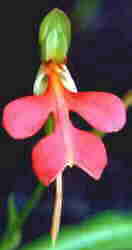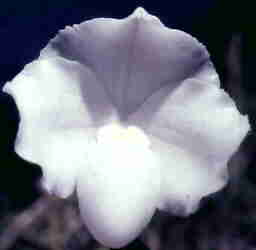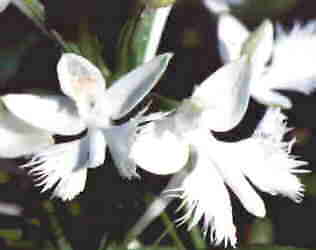
BP SPECIES NEWSLETTER DECEMBER 2001

Photos in this issue: Habenarias rhodochila
above, Habenaria dentata. Paph niveum
Do you know any orchid growers who may like to receive this newsletter?
Why not forward this email to them now!Email bporchid@ultra.net.au
for emailed plant and flask lists or visit our web site at www.ultra.net.au/~bporchid/mailingList.html
and fill in the online form.
Items in this newsletter may be reproduced provided source acknowledged.
We commend "Orchids Online Web Design"
for the excellent work on our web site and this Newsletter.
For information or prices click
here or email Steve at orchids@bit.net.au
A.
What's New in flask.
Paph niveum x godfroyeae remakes
what is considered to be the natural hybrid Paph angthong.
A lovely slipper, one or two flowers on a tall erect spike, the flowers
are usually rounded, cupped with wide sepals and petals.
The colour ranges from almost white to a cream white with varying
amounts of red purple spots and blotches, the egg like pouch labellum usually
white. With nice clean colours, this is a showy species that is fairly
easy to grow in a heavily shaded area. Use small
deep pots, fine bark plus shredded isolite with a little peat moss or coconut
peat mixed in for a little extra moisture. We grow under cover to keep
excess rain off the plants.
Haemaria discolor alba x alba , described in the
November newsletter, is also germinating. This promises to be something
special as two clones were sib crossed for the clear green and silver veined
leaf.
TOP
B.
What's ready to replate NOW. Photo
Paphiopedilum niveum
 Paph
niveum, the showy well presented white with fine red spots. Our
second sowing, the first sowing are flowering out of flask with very nice
elegant white flowers finely spotted red on a tall spike. The small growing,
mottled foliage makes it an very attractive foliage plant as well.
Sievikingia suavis, a cooler grower with intricate
yellow and orange flowers, has developed to a good size in flask ready
for the final replate. This is a small growing epiphyte, almost minature,
usually grown in spaghnam moss, allied to Stanhopea, but
much smaller. A very small slatted basket with spaghnam moss is recommended
Stanhopea martiniana, a large showy white flower
with red markings from Mexico. Good strong plantlets ready for the final
replate now.
Galeottia grandiflora ( Mendonsella grandiflora)
is a very showy Central American species with flowers to 8cm. Very striking
yellow green, with broad redbrown strioes. The complex lip is white with
red stripes, fringed and with intricate keels.These seedlings are at a
prime stage for the final replate to fill the flasks for airmail post.
TOP Paph
niveum, the showy well presented white with fine red spots. Our
second sowing, the first sowing are flowering out of flask with very nice
elegant white flowers finely spotted red on a tall spike. The small growing,
mottled foliage makes it an very attractive foliage plant as well.
Sievikingia suavis, a cooler grower with intricate
yellow and orange flowers, has developed to a good size in flask ready
for the final replate. This is a small growing epiphyte, almost minature,
usually grown in spaghnam moss, allied to Stanhopea, but
much smaller. A very small slatted basket with spaghnam moss is recommended
Stanhopea martiniana, a large showy white flower
with red markings from Mexico. Good strong plantlets ready for the final
replate now.
Galeottia grandiflora ( Mendonsella grandiflora)
is a very showy Central American species with flowers to 8cm. Very striking
yellow green, with broad redbrown strioes. The complex lip is white with
red stripes, fringed and with intricate keels.These seedlings are at a
prime stage for the final replate to fill the flasks for airmail post.
TOP
C. What's new in Plants.
Dend engae, Paph niveum, Thrixspermum.
Seedlings of Dend engae, the showy New Guinea species,
are doing nicely in a slotted pot in spaghnam and shredded isolite mix.
Habenarias dentata, susaneae, and ochroleuca are shooting
up after their dormancy. Nervilia uniflora (see our web page
for photos) have increased their tubers this season and a few flowering
size plants are now available.
Paphiopedilum niveum, flowering size plants in 10
cm pots. Thrixspermum centipeda, flowering size, some in
spike now, growing well on pieces of cork.
TOP
D. HABENARIAS
are easy to grow...
The prime requisite for growing these is to remove the pots from
the orchid house in winter and let them dry out. A very ocassional watering
will prevent the tubers drying out too much or if the pots are left where
they will get any natural rainfall, that is usually sufficient
Before spring, the tubers should be repotted into fresh media.
We use a mixture of old composted bark, some fresh fine bark and about
50% shredded isolite. For extra moisture, a little coconut peat is added.
A small pot of 10 cm or so is adequate.
S On repotting, add a liberal sprinkling of processed fowl manure
or similar slow acting fertiliser on top of the media and then lots of
water. While the plants are growing, they like a lot of water, but this
should be decreased once the flowers have opened. After flowering, the
plants should only be watered while the leaves are still green. Once the
leave have dropped, stop watering.
Most Habenarias can be grown under similar light
conditions to that of Dendrobium, short of sunburn. Avoid
water dripping onto the foliage, as this tends to damage the leaves and
causes them to blacken and rot, a problem with heavy rain. Spikes if very
tall should be staked to support the often heavy head of flowers.
 Habenaria
dentata will produce a spike to 70 cm high, with up to 8 or 10
pure white fringed flowers, each to about 2.5 cm long. A native of India
thru to China, it is a quick growing and very easily grown species.
Habenaria rhodochila is a species of South East Asia,
red flowered, with orange, yellow and pink colour forms. The foliage is
mottled, requiring a little more shade than the green leafed H.dentata.
It is often a lithophyte and does best in a well drained media of composted
bark etc that simulates the natural compost of leafmould and forest litter.
One grower uses a good quality potting
mix from the supermarket, and repots yearly.
Both species will produce extra tubers to provide a specimen pot
and more flowers. Several plants in one pot will produce a showy exhibit,
equal to any species. Text & photos at web page Ian Walters.
TOP Habenaria
dentata will produce a spike to 70 cm high, with up to 8 or 10
pure white fringed flowers, each to about 2.5 cm long. A native of India
thru to China, it is a quick growing and very easily grown species.
Habenaria rhodochila is a species of South East Asia,
red flowered, with orange, yellow and pink colour forms. The foliage is
mottled, requiring a little more shade than the green leafed H.dentata.
It is often a lithophyte and does best in a well drained media of composted
bark etc that simulates the natural compost of leafmould and forest litter.
One grower uses a good quality potting
mix from the supermarket, and repots yearly.
Both species will produce extra tubers to provide a specimen pot
and more flowers. Several plants in one pot will produce a showy exhibit,
equal to any species. Text & photos at web page Ian Walters.
TOP
E. Web page.
Check out our web page www.ultra.net.au/~bporchid
This is constantly under revision and you will find heaps of colour
photos, articles on species in cultivation and in the wild, plus links
to other interesting species orchids, and more photographs. Check out the
photos of species mentioned above
TOP
F. Humour.
Pet crabs..
Queensland female mud crabs are protected. An inspector caught a man walking
up the river bank with a bucket containing 2 female crabs.
"You know it is illegal to take female crabs."
These aren't illegal crabs, they are my pets and I have just taken
them for a swim in the river. I let them swim around and when I whistle,
they come back and jump into the bucket.
" I don't believe you" said the inspector.
Well, I'll let them swim and you can watch me whistle them back. So
he does, and the crabs swim off.
"Well, are you going to whistle those crabs back now?"
What crabs???
The legal word.
Pop singer D** H**** is being sued by a fan who claims he beaned her on
the forehead with a maraca during one of his concerts. M*** A** H***, 43,
who describes herself as a long-time H**** fan, says the former E*****
rocker hit her with the rattling instrument after she stood to take a photograph
during his October 4 concert in North Little Rock.
In her lawsuit filed in state court, M*** claims H**** then pointed
at her and made other gestures when announcing that he would appreciate
no more flash photography.
The lawsuit seeks unspecified compensatory and punitive damages. "These
affronts, coupled with her physical injury, caused highly unpleasant mental
reactions including fright, horror, disappointment, chagrim, worry,
disgrace, embarrassment, indignity, ridicule, grief, shame, humiliation,
anger and outrage," the lawsuit says.
No doubt pop singer D** H**** felt exposed, affronted, accosted,
menaced, dazzled, taken aback, threatened, put upon, insulted, defenceless,
vulnerable, injured, slighted, upset, disrespected and advised his
legal representitive, lawyer, solicitor, counsel, legal eagle, advocate,
adviser, consultant, attorney, brief, notary, accordingly.
We trust the legal people, each with their thesaurus, will sort
it out. ( Apologies for the verbosity, the letter of the law seems to be
getting out of hand.)
TOP
G. Unsubscribe
To have your name removed from the mailing list, email bporchid@ultra.net.au
and send subject "Unsubscribe me please!" or click
here
TOP
Yours in orchids,
Ian and Pat Walters, Burleigh Park Orchid Nursery
54 Hammond Way, Thuringowa, Australia 4815
Email us at bporchid@ultra.net.au
www.ultra.net.au/~bporchid
|
TOP |
MAIN |
ABOUT |
FLASK |
PLANT |
ORDER |
INTEREST |
SUPPLIES |
EMAIL |
LINKS
|


 Paph
niveum, the showy well presented white with fine red spots. Our
second sowing, the first sowing are flowering out of flask with very nice
elegant white flowers finely spotted red on a tall spike. The small growing,
mottled foliage makes it an very attractive foliage plant as well.
Paph
niveum, the showy well presented white with fine red spots. Our
second sowing, the first sowing are flowering out of flask with very nice
elegant white flowers finely spotted red on a tall spike. The small growing,
mottled foliage makes it an very attractive foliage plant as well. Habenaria
dentata will produce a spike to 70 cm high, with up to 8 or 10
pure white fringed flowers, each to about 2.5 cm long. A native of India
thru to China, it is a quick growing and very easily grown species.
Habenaria
dentata will produce a spike to 70 cm high, with up to 8 or 10
pure white fringed flowers, each to about 2.5 cm long. A native of India
thru to China, it is a quick growing and very easily grown species.